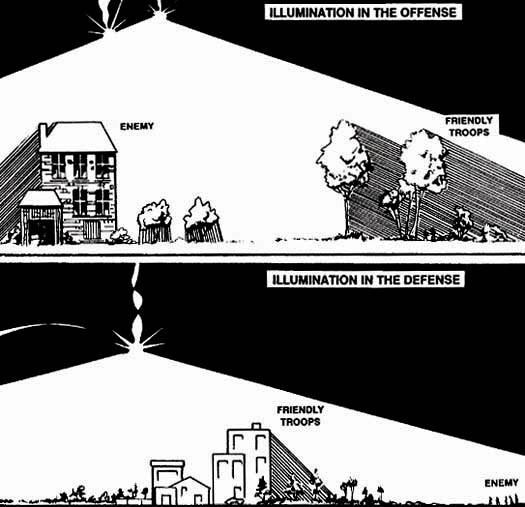 [Image: "Trip flares, flares, illumination from mortars and artillery, and spotlights (visible light or infrared) can be used to blind [the] enemy... or to artificially illuminate the battlefield," from An Infantryman's Guide to Combat in Built-Up Areas].
[Image: "Trip flares, flares, illumination from mortars and artillery, and spotlights (visible light or infrared) can be used to blind [the] enemy... or to artificially illuminate the battlefield," from An Infantryman's Guide to Combat in Built-Up Areas].In another army field manual, for instance, called Tactical Employment of Mortars, the practice of running "illumination missions" using "luminous markers" and "specified amounts of illumination ammunition" is explained, such that mortars become less kinetic weapons used in the destruction of buildings than surprise lighting effects—decentralized chandeliers, so to speak, hurled down from above at high speed.
Indeed, "medium and heavy mortars can provide excellent illumination over wide areas," whereas with lighter rounds "the illumination lasts for about 25 seconds, and it provides moderate light over a square kilometer. The gunner must adjust the elevation to achieve height-of-burst changes for this round. The best results are achieved with practice."
One of many reasons I mention this here is because I wonder how these techniques could be de-weaponized and used for the purpose of civilian illumination. You visit a small town somewhere in Scandinavia where night's fall is disturbingly total, with no street lights of any kind turning on after the sun has long since set; yet people are still out there milling about, even sitting on public benches with books in hand, as if preparing to read in utter darkness. But then a lightburst flashes in the sky above, burning for half a minute or more; and then another; and another, at odd angles, turning the streets and squares below into stroboscopes of moving geometry; and this continues for hours—strange nets of light popping in the air above you—as the city goes about its unexpected nightlife, illuminated by repurposed mortars fired by a light brigade camped out on the urban fringe.
Finally, any discussion of how urban lighting effects can be militarized reminds me of a stunning scene from Anthony Beevor's retelling of the fall of Berlin during World War II. There, we read of a Russian general who ordered such extraordinary use of spotlights during the Battle of the Seelow Heights that his own soldiers became totally disoriented when the shelling began: massive clouds of smoke and dust rose up into the beams, forming an impenetrable glowing mist that quickly enveloped them, robbing the battlefield of detail. Light came from every direction and no direction at all, in a complete loss of the shadow-casting effects needed to hide their own troops' movement—a failure, we might say, of military chiaroscuro, or the controlled use of shadows during invasion as seen in the diagram, above.
No comments:
Post a Comment